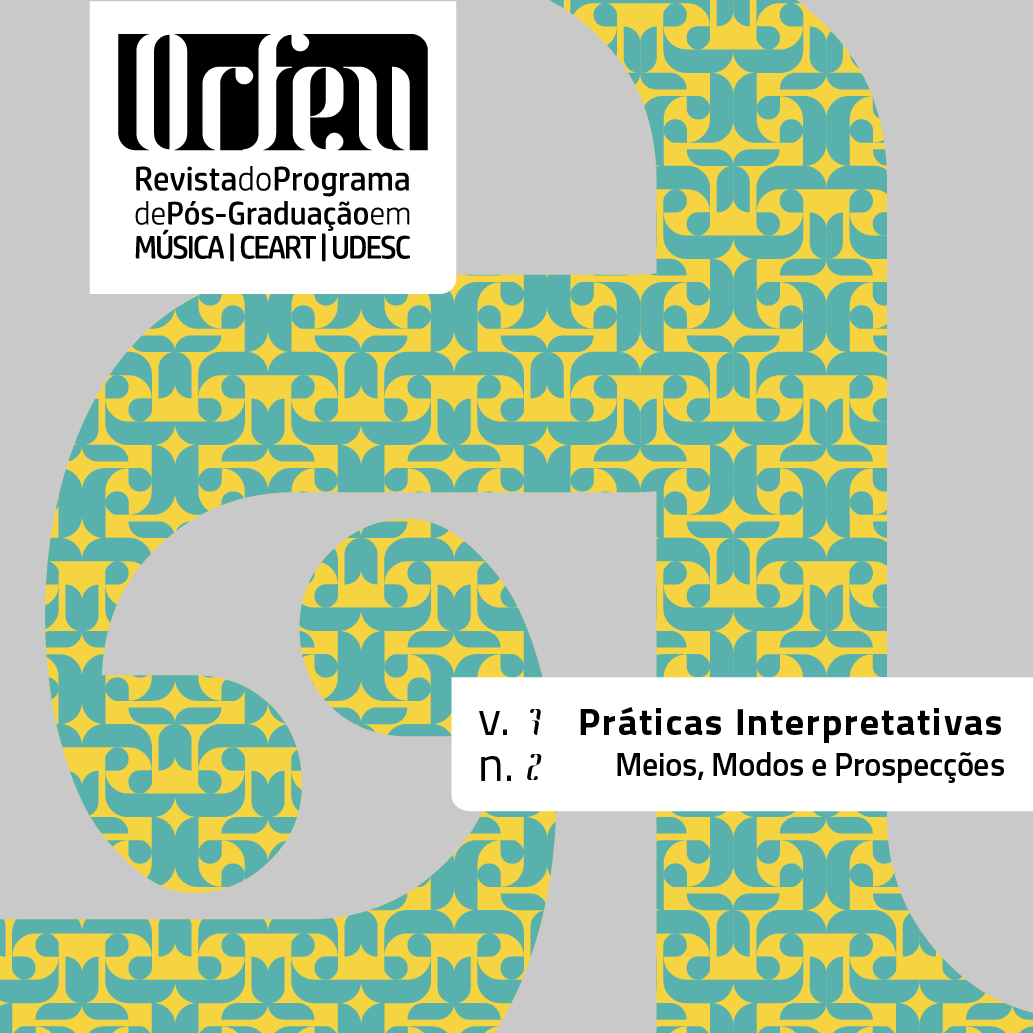Composição pela concatenação de fragmentos independentes
DOI:
https://doi.org/10.5965/2525530407022022e0203Palabras clave:
planejamento composicional, teoria do conjuntos de classes de altura, pedagogia da composição musicalResumen
Neste artigo, é descrito um plano de trabalho composicional, de natureza pedagógica, partindo dos conteúdos teóricos dos seis capítulos do livro de Straus (2013) intitulado Introdução à Teoria Pós-Tonal. A ideia central consistiu em demonstrar o planejamento, a composição e a posterior concatenação de seis fragmentos independentes, com participação ativa de cinco alunos de composição, focalizando os seguintes tópicos: tipos intervalares, classes de conjuntos, operações entre conjuntos de classes de alturas, relações de contorno, relação Z, formações escalares, dodecafonismo, combinatoriedade, derivação, multiplicação e serialismo integral. Concomitantemente ao referencial teórico pós-tonal, cinco premissas pedagógicas originais serviram de guia durante cada etapa do trabalho. Os seis fragmentos, cada um com aproximadamente trinta segundos, foram, em seguida, concatenados, levando-se em consideração seis procedimentos originais propostos pelo autor, de maneira a produzir uma obra coerente de cerca de três minutos, para quinteto de sopros.
Descargas
Citas
ADORNO, Theodor. Music, Language, and Composition. Trad. Susan Gillespie. The Musical Quarterly, v. 77, n. 3, p. 401-414, 1993.
ANAGNOSTOPOULOU, Christina. Lexical cohesion in linguistic and musical discourse. In: ESCOM, 3.,1997. Proc. […]. [S. l.: s. n.], 1997. p. 655-660.
BARBOSA, Hildegard; SANTOS, Raphael Sousa; PITOMBEIRA, Liduino. Lewin: desenvolvimento de uma calculadora de classes de altura com funções analíticas e composicionais. In: Congresso da ANPPOM, 25., 2015. Anais... 2015, p. 1-8.
BOULEZ, P. A música hoje. São Paulo: Perspectiva, 1972.
BROWN, Gillian; YULE, Geroge. Discourse Analysis. Cambridge: Cambridge University Press, 1983.
DE BEAUGRANDE, Robert; DRESSLER, Wolfgang. Introduction to Text Linguistics. London: Longman, 1981.
EMMERSON, Simon. Composing Strategies and Pedagogy. Contemporary Music Review, v .3, p. 133-144, 1989.
FORTE, Allen. The Structure of Atonal Music. New Haven: Yale Univ. Press, 1973.
FERREIRA, Esdras Sarmento; SANTOS, Raphael Sousa; LIMA, Flávio Fernandes de; CARVALHO, Hugo Tremonte de; PITOMBEIRA, Liduino. Sistema Composicional Intermarkoviano. Revista Vórtex, Curitiba, v. 8, n. 2, p. 1-46, 2020.
HARRIS, Simon. A proposed classification of chords in early twentieth-century music. New York: Garland, 1989.
GOLDMAN, Jonathan. The Musical Language of Pierre Boulez: Writings and Compositions. New York: Cambridge Univ. Press, 2011.
HALLIDAY, Michael; HASAN, Ruqaiya. Cohesion in English. London: Longman, 1976.
HEINEMANN, Stephen. Pitch-class Set Multiplication in Theory and Practice. Music Theory Spectrum, v. 20, n. 1, p. 72-96, 1998.
HINDEMITH, Paul. The Craft of Musical Composition. New York: Schott, 1970.
KOHS, Ellis. Musical Form: Studies in Analysis and Synthesis. Boston: Houghton Mifflin Company, 1976.
KOSTA, Stefan. Materials and Techniques of Twentieth-Century Music. 3. ed. Upple Saddle River, New Jersey: Prentice Hall, 2006.
KOBLYAKOV, Lev. Pierre Boulez: a World of Harmony. New York: Harwood, 1990.
KRISTEVA, Julia. A História da Linguagem. Lisboa: Edições 70, 1969.
LACHENMANN, Helmut. Vier Grundbestimmungen des Musikhörens [1979]. In: LACHENMANN, Helmut. Musik als existentielle Erfahrung: Schriften 1966-1995. Wiesbaden: [s. n.], 1996. p. 54-62.
MAIA, Lucas Simões. Formalismos da composição algorítmica: um experimento com canções folclóricas brasileiras. Dissertação (Mestrado em Engenharia Elétrica) – Programa de Engenharia Elétrica, Universidade Federal do Rio de Janeiro, Rio de Janeiro, 2016.
MEDEIROS, Rubem; SANTOS, Raphael Sousa; PITOMBEIRA, Liduino. Modelagem Sistêmica baseada em Cadeias de Markov. In: Congresso da ANPPOM, 21, 2011. Anais... 2011, p. 1879-1885, 2011.
MENEZES, Flo. Apoteose de Schoenberg. São Paulo: Ateliê Editorial, 2002.
MESQUITA, Gabriel. A acústica da influência: uma decomposição da intertextualidade na música. Dissertação (Mestrado em Música) – Programa de Pós-Graduação em Música, Universidade Federal do Rio de Janeiro, Rio de Janeiro, 2018.
OJALA, Juha. Space in Musical Semiosis: An Abductive Theory of the Musical Composition Process. Helsinki: Hakapaino, 2009.
PACCIONE, Paul. Chromatic Completion: Its Significance in Tonal and Atonal Contexts. College Music Symposium, v. 28, p. 85-93, 1988.
PITOMBEIRA, Liduino. Compositional Systems: Overview and Application. MusMat: Brazilian Journal of Music and Mathematics, v. 4, n. 1, p. 39-62, 2020.
PITOMBEIRA, Liduino. Compositionality as Creative Identity Building. Musica Theorica, v. 4, n. 2, p.113-133, 2019.
PITOMBEIRA, Liduino. A Systemic Model for Debussy’s Prelude n. 1. MusMat: Brazilian Journal of Music and Mathematics, v. 2, n. 2, p. 37-56, 2018.
PITOMBEIRA, Liduino. Diálogos entre a Musicologia e a Composição à luz de três modelos composicionais. In: VOLPE, Maria Alice. (Org.). Teoria, Crítica e Música na Atualidade. Série Simpósio Internacional de Musicologia. Rio de Janeiro: Universidade Federal do Rio de Janeiro / Escola de Música/PPGM, v. 2, p. 261-272, 2012.
SAMPAIO, Marco da Silva. A Teoria de Relações de Contornos Musicais: inconsistências, soluções e ferramentas. Tese (Doutorado em Música) – Programa de Pós-Graduação em Música, Universidade Federal da Bahia, Salvador, 2012.
SOUZA, Rodolfo Coelho de. Sintaxe e parataxe na música moderna e pós-moderna. Opus, Goiânia, v. 13, n. 2, p. 73-91, dez. 2007.
STRAUS, J. Introdução à Teoria Pós-Tonal. Trad. Ricardo Bordini. Salvador: EDUFBA, 2013.
SOUSA, Daniel; OLIVEIRA, Helder; PIRES, Leandro; PADRÃO, Lucas; RIBEIRO, Roberto; TRINDADE, Vilane; PITOMBEIRA, Liduino. Perfis composicionais como base metodológica para a modelagem do Prelúdio n.2 de Santoro. Revista Vórtex, v. 9, p. 1-52, 2021.
TYMOCZKO, Dmitri. A Geometry of Music: Harmony and Counterpoint in the Extended Common Practice. Oxford: Oxford University Press, 2011.
WANG, Yuan; GUO, Ming. A Short Analysis of Discourse Coherence. Journal of Language Teaching and Research, v. 5, n. 2, p. 460-465, 2014.
Publicado
Cómo citar
Número
Sección
Licencia
Derechos de autor 2022 Liduino José Pitombeira de Oliveira

Esta obra está bajo una licencia internacional Creative Commons Atribución 4.0.






